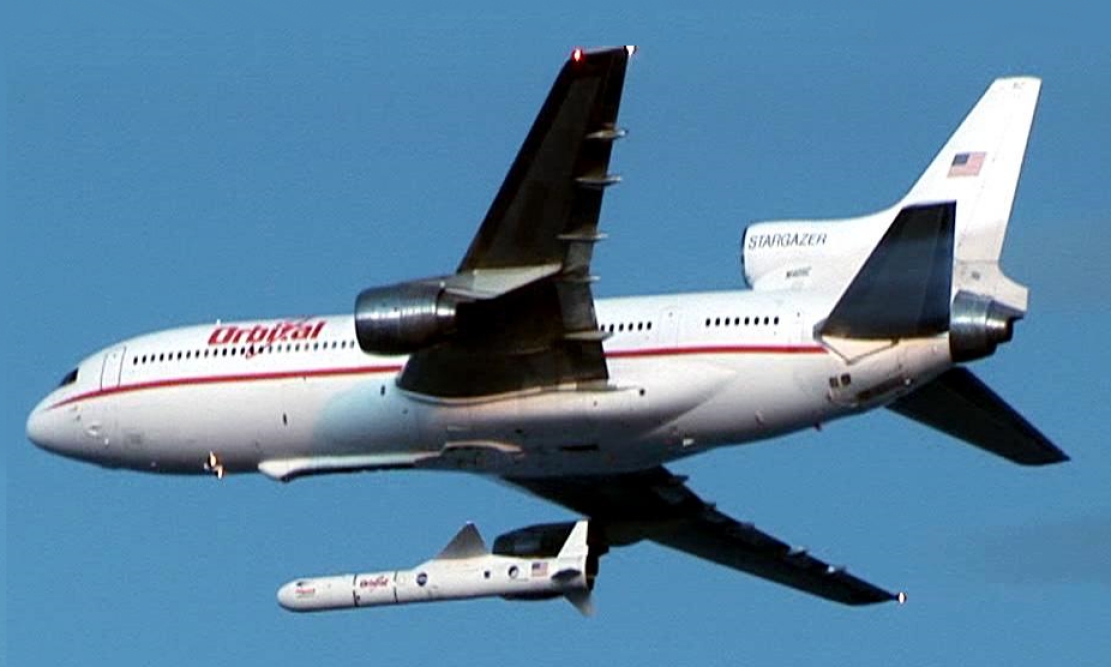
Pegasus
In-activeOrbital Sciences Corporation (OSC)
April 5, 1990
Description
The Pegasus is an air-launched rocket developed by Orbital Sciences Corporation (now part of Northrop Grumman Innovation Systems). Capable of carrying small payloads of up to 443 kilograms (977 lb) into low Earth orbit, the vehicle consists of three solid propellant stages and an optional monopropellant fourth stage. Pegasus is released from its carrier aircraft at approximately 40,000 ft (12,000 m), and its first stage has a wing and a tail to provide lift and attitude control while in the atmosphere.
Specifications
-
Stages
3 -
Length
16.9 m -
Diameter
1.27 m -
Fairing Diameter
― -
Launch Mass
18.0 T -
Thrust
580.0 kN -
Apogee (Sub-Orbital)
4000.0 km
Family
-
Name
Pegasus -
Family
― -
Variant
― -
Alias
― -
Full Name
Pegasus
Payload Capacity
-
Launch Cost
$40000000 -
Low Earth Orbit
443.0 kg -
Geostationary Transfer
Orbit
― -
Direct Geostationary
― -
Sun-Synchronous Capacity
―
Orbital Sciences Corporation
Commercial
None
OSCNone
Pegasus | APEX
Orbital Sciences Corporation | United States of AmericaAir launch to orbit
Aug. 3, 1994, 2:38 p.m.
Status: Launch Successful
Mission:
APEX (Advanced Photovoltaic & Electronic Experiment) successfully tested a wide array of advanced photovoltaic and electronic components in a harsh radiation environment, provided significant data to support improved designs for future space systems. During operation, APEX's highly elliptical orbit allowed the investigation of space plasma effects on high-voltage operation (current leakage at positive voltages and arcing at negative voltages) in the perigee region, plus the investigation of space radiation effects (decreased array power output from passage through the inner radiation belt) in the apogee region.
Elliptical OrbitPegasus | Array of Low Energy X-ray Imaging Sensors (ALEXIS)
Orbital Sciences Corporation | United States of AmericaAir launch to orbit
April 25, 1993, 1:56 p.m.
Pegasus | Satélite de Coleta de Dados-1 (SCD-1)
Orbital Sciences Corporation | United States of AmericaAir launch to orbit
Feb. 9, 1993, 2:30 p.m.
Long March 7A
Yaogan 46
201 - Wenchang Space Launch Site, People's Republic of ChinaClassified Earth observation satellite officially reported as for "national resources/hydrology/meteorology surveying & disaster management" purposes.
LVM-3 (GSLV Mk III)
CMS-03 (GSAT-7R)
Satish Dhawan Space Centre Second Launch Pad - Satish Dhawan Space Centre, IndiaCommunications Satellite for the Indian Navy, replacing GSAT-7 for secure real-time links between Indian warships, submarines, aircraft, and shore-ba…
Falcon 9
Bandwagon 4 (Dedicated Mid-Inclination Rideshare)
Space Launch Complex 40 - Cape Canaveral SFS, FL, USADedicated rideshare flight to a mid-inclination orbit with dozens of small microsatellites and nanosatellites for commercial and government customers.
Falcon 9
Starlink Group 11-23
Space Launch Complex 4E - Vandenberg SFB, CA, USAA batch of 28 satellites for the Starlink mega-constellation - SpaceX's project for space-based Internet communication system.
Long March 2
Shenzhou 21
Launch Area 4 (SLS-1 / 921) - Jiuquan Satellite Launch Center, People's Republic of ChinaTenth crewed flight to the Chinese space station.

